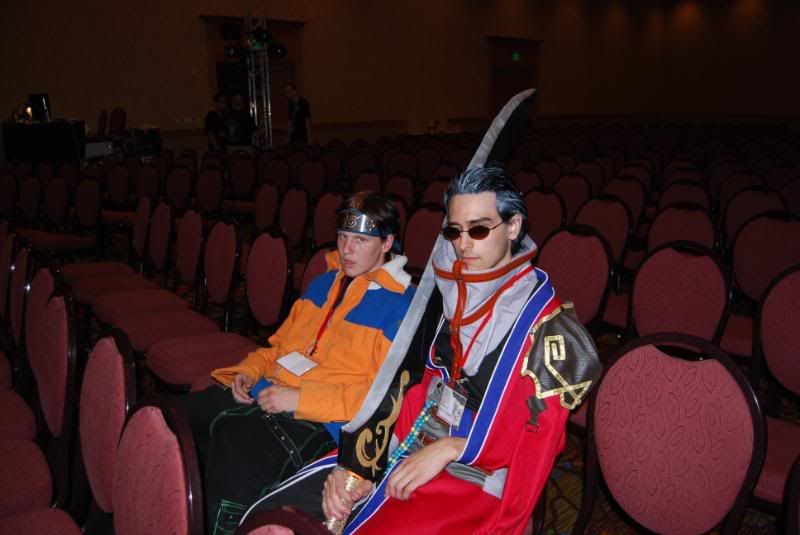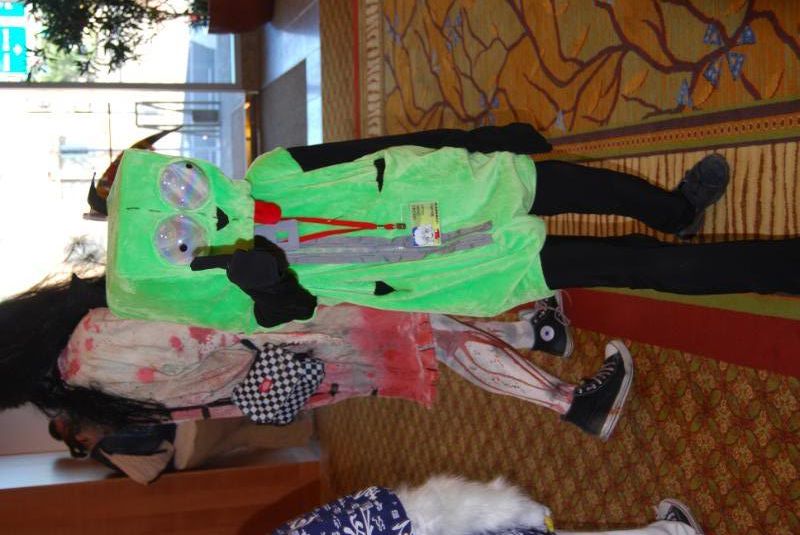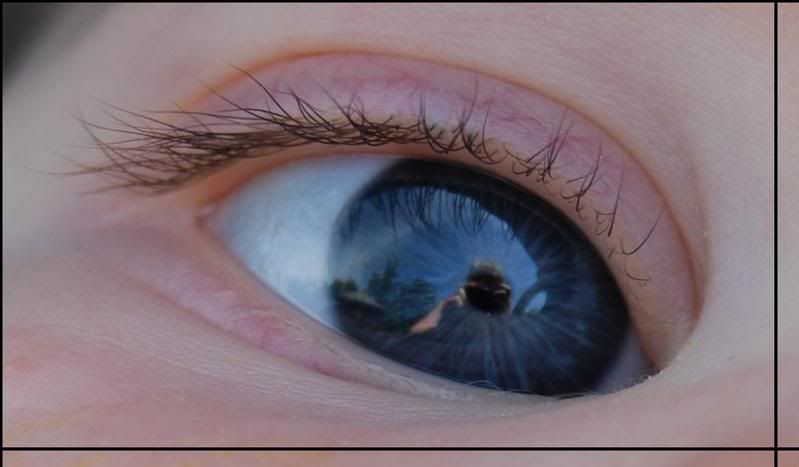Tuesday, November 27, 2007
Saturday, September 8, 2007
Grr.
I am very upset.
My blog has like NO traffic!!
How am I supposed to pursuit a writing career if nobody even looks at the pictures in my book?!
Where do I get my big shot? I don't even have 15 minutes of fame. I have zip minutes of no fame!
I fail at this blog thing - miserably!
-----
Now for the blogging part.
-----
I went to chris's birthday party!
It was fun
I got him a dog.
Sorry, I didn't bring a camera, so I didn't take any pictures (funny how that works).
I kinda feel like I didn't stay long enough... but thats okay. I didn't wanna party in my skirt and pig tails while les went to work!
But hopefully chris had a happy bday and liked his little squeeky dog :D
laterz
<3 Logic's Enemy
My blog has like NO traffic!!
How am I supposed to pursuit a writing career if nobody even looks at the pictures in my book?!
Where do I get my big shot? I don't even have 15 minutes of fame. I have zip minutes of no fame!
I fail at this blog thing - miserably!
-----
Now for the blogging part.
-----
I went to chris's birthday party!
It was fun
I got him a dog.
Sorry, I didn't bring a camera, so I didn't take any pictures (funny how that works).
I kinda feel like I didn't stay long enough... but thats okay. I didn't wanna party in my skirt and pig tails while les went to work!
But hopefully chris had a happy bday and liked his little squeeky dog :D
laterz
<3 Logic's Enemy
Thursday, September 6, 2007
Fun.
Over the long weekend, I went with Les and Gerro to Kumoricon. It was lots and lots of fun. My first con ever... actually, my first anime event ever. I am looking forward to Sakuracon.
 This is Les and Gerro, tired and somewhat bored at a non-eventful point of the con. Shortly afterward, Gerro's picture was taken, and Les and I were in the background. The pic is at 45 seconds of this video
This is Les and Gerro, tired and somewhat bored at a non-eventful point of the con. Shortly afterward, Gerro's picture was taken, and Les and I were in the background. The pic is at 45 seconds of this video
I also got to meet Gir. I was stoked!

But yeah, that was my Kumoricon. :D
I also got to meet Gir. I was stoked!
But yeah, that was my Kumoricon. :D
Thursday, August 9, 2007
Monday, July 23, 2007
Wednesday, June 27, 2007
Wednesday, June 20, 2007
Monday, June 18, 2007
my essay... frikkin UGH
Accidental Epiphanies in Alice Munro’s Writing
Stacy [last name here]
June 12, 2007
Dr. Thompson
Eng102
Outline
Thesis Statement: Accidental epiphanies by women appear throughout Alice Munro’s writing.
I. Epiphanies
A. reasoning for thesis
B. thesis statement
II. What I mean by my theses
A. Her characters are always female, and the stories are usually problems faced by an every-day girl/woman. Explain what sort of problems
B. At the end of each story, the main character has learned something about herself. Munro doesn’t say this outright, but it is implied by the characters actions or talk of change in their life afterward.
III. An Ounce of a Cure
A. Give a short summary of this story, and analysis of the characters.
B. Note the changes that happen to her at the end of the story, what she’s learned, and how Munro shows it.
1. Quote
2. Relevance
IV. Dance of the Happy Shades.
A. Short summary/analysis
B. Note changes that happen at end, things learned, and how it’s shown
1. Solid examples from text
2. How it’s relevant
V. Differently.
A. Summary/analysis.
B. Note changes, lessons, and how Munro shows this
1. long quote
2. Explain quote and relevance
VI. Runaway.
A. Summary/analysis
B. Changes, lessons, and how Munro shows this
1. several short relevant quotes with
2. explanations
VII. Her experiences and her writing
A. all four stories relating to one another
B. Life in ontario
VIII. Conclusion
A. what’s been said
B. Emphasis on thesis
Accidental Epiphanies in Alice Munro’s Writing
Stories pass by eyes daily, and trends of the author often go unnoticed. A book, a story, an article is read, thought about momentarily, then forgotten, released, history to the reader, who just moves on to the next one. If care is taken to notice trends in writing, more can be gathered about each individual story. One Canadian writer and recipient of several awards is an example of this. Accidental epiphanies by women appear throughout Alice Munro’s writing. In each of Munro’s stories, her readers are introduced to a different female; each with their own problems, friends, and stories. At the end of every story the protagonist has learned who they are.
The female characters in Munro’s stories range from young to old and their problems are just as diverse. From a girl who drinks too much her first time, to a woman who cheats on her husband, to a young pianist and her elderly ditsy piano teacher, only a few constants are left – the female protagonists and their accidental epiphanies. Something about each character’s life either has changed or is going to, and it’s because the character now understands herself better than before. Their lives change by events such as moving, or having a different understanding on things or people surrounding their lives.
In “An Ounce of a Cure,” Munro introduces us to a young girl who’s at someone else’s house, babysitting. Once she had sent the children to bed, she observed the different bottles of alcohol spread out on the counter. Deciding she’d have a glass, she was unaware that people normally dilute hard alcohol with some other drink, and she filled it to the top with all different kinds mixed together. She was having a hard time with a boy at school, and she thought drinking would sort of buzz her, and lift her up to a place where she could be happy. Instead, she got terribly drunk, and sick. She ended up calling her best friend over to take care of her. Within the next few days, rumors had spread that she drank trying to kill herself over this boy, and she learned to ignore them. She began to realize the little things aren’t as important as things like family and friends. Munro doesn’t write “I came to the conclusion that I’d be a better person if…” or anything that suggests this character noticed herself being changed for life, but the reader understands that from what’s implied in the writing (Munro).
I felt that I had had a glimpse of the shameless, marvelous, shattering absurdity with which the plots of life, though not of fiction, are improvised. I could not take my eyes off it… … I knew that he had been surprised by a memory either of my devotion or my little buried catastrophe. I gave him a gentle, uncomprehending look in return. I am a grown-up woman now; let him unbury his own catastrophes. (Munro “Ounce” 538)
Another story written by Munro called “Dance of the Happy Shades” is about a girl who is learning piano from a woman who seems to have no ability to teach it. All of her students tend to be more on the piano plunking side than the piano playing side. Her recitals, which the teacher always called parties, were always somewhat boring and non-musical; until one day. Many students she had never seen before came through the door while the young girl was playing. While the main character was playing, she observed many students she had never seen before come through the door. Later, when one of the new students started to play she played so beautifully that the young girl and her mother, and everyone else and their mothers, were largely impressed. Everyone then had a new look on the teacher and her abilities. They started to think maybe they were wrong about her (Munro).
“Differently” tells a story about a woman who falls in love young, then cheats on her husband years later. The man she cheats with then becomes somewhat violent and she breaks it off, just to have him turn to her best friend for sex, and she gives it to him. Infidelity and distrust occur often in relationships that started at a young age. The problems the main character faces are somewhat off the wall. For example, she had to lie to her babysitter after an affair on the beach. There is perhaps a better example, though. At one point, she imagines that maybe her husband, who is supposedly on a trip somewhere, could be doing the same thing she is. In a way this helps her to justify her actions, and makes her wonder if the life she’s leading is the one for her after all. In the end, she winds up leaving her husband and all the events behind. She starts a whole new life for herself when she realizes she was living the wrong one. Maybe what Munro was trying to show is that it takes a mistake to figure out where your life is headed (Munro).
In a book called Runaway, a story with the same title is the first in the collection. This story is long, compared to most of her stories, and the plot is much more extensive. This story’s about a woman and her neighbor. The woman, Carla, had helped her neighbor, Mrs. Jamieson (Sylvia) cope after her husband died. The neighbor felt a strong bond to the woman after that.
While Sylvia was in Greece, her affection grew for Carla, and back at home, Carla began to dislike her husband. Their goat had run away, and their horse-lesson business wasn’t doing very well. She was on an emotional rollercoaster, and when Mrs. Jamieson came back, Carla explained everything to her. She included how badly her husband had been treating her, and concluded with her wish to get away. Her neighbor helped her out with some money and a place to stay a few cities away, then gave her a ride to the bus stop.
Once on the bus, the woman changes her mind, gets off and calls her husband to come and get her. While the husband tells Mrs. Jamieson to stay out of their lives, the goat appears. The husband didn’t take the goat home though, and when Carla found out, she decided not to ask him why, and will forever wonder what happened to their goat.
When Carla decides not to ever ask her husband why he didn’t bring the goat back, she has figured out who she is. She is a person who doesn’t like change, and no longer wants to start anything. She’s started her life over before, and that’s just not something she wants to do again. Carla also learns from her little adventure that she’s got what she wants out of life, and she doesn’t need to look for it somewhere else, and now that she’s threatened to, her husband seems to care a bit more about her feelings.
“Royal Beating. That was Flo’s promise. You are going to get one Royal Beating.” The story “Royal Beatings” is about a girl named Rose, who’s mother had died because of a blood clot. Her father re-married to a woman named Flo. Flo was a mouthy, gossipy, and seemingly annoying woman of about thirty or forty years old (Munro).
The struggle Rose has, is relatively the same as any other teenager. She wants to hate her parents. They fight with her all the time, and her father tends to knock her around quite a bit. She really wants to hate Flo, her step mom, for always “tattle-tailing” on her to her dad, who then gives her a “royal beating” which isn’t actually that bad at all (Munro).
She grows up this way, and after every beating, Rose caves in to sandwiches and sweets so as to make everything normal again. Flo always told stories about different things, and one particular story she told was about an old man, who was old then. When Rose grew up, she heard an interview with this man, and he was one hundred and two years old. That was when Rose realized she actually never hated her step mom at all. In fact, the only person she wanted to tell this to was Flo, but by then Flo was way too old and out of it to know what Rose was saying (Munro).
Rose grew up thinking one thing, that she hated her parents. It took an old man several years later to make her figure out what was true, and this is when she learned something about herself. This is her great epiphany.
All five of these stories are great examples of the epiphanies encountered in Munro’s stories. It begins to be more than a coincidence once you’ve read so many stories. This is a pattern Munro follows. The back of her books contain short biographies of her life. She lives with her husband in Ontario, and this is where most of her stories take place. The lifestyle where she lives is a lot different than that of a big city. In an interview with Vintage Books, Munro said, “I think there's perhaps an advantage living here of knowing more different sorts of people than you would know in a larger community (where you'd be shut up, mostly, in your own income or educational or professional ‘class’)” (Vintage). The problems faced by these women are problems that she feels happen around her, but “Human experience though doesn't seem to me to differ, except in fairly superficial ways, no matter what the customs and surroundings” (Vintage).
Critic David Skinner calls Munro’s stories “well-proportioned studies of women in various stages of life and self-understanding.” He also says that most of her stories “employ classic devices of life-changing confusion, where a misapprehension or a lie leads to a completely different future for everyone involved.” It is important to note Skinner’s opinion. Not only does it imply that Munro’s main characters’ lives are changed, but everyone involved are also changed (Skinner).
Once a story is read, and thought about, it is often forgotten so quickly afterward that not much thought is put into comparison. Do Alice Munro’s stories have a recurring pattern of women and their epiphanies? Yes. It can be concluded that Munro is an author with a pattern of characters and plots.
Works Cited
Munro, Alice. “An Ounce of a Cure.” The Compact Bedford Introduction to Literature.
Ed. Micheal Meyer. 7th ed. Boston: Bedford/St. Martin’s, 2006.
Munro, Alice. “Dance of the Happy Shades.” Selected Stories. New York: Knopf. 1996. 16-25.
Munro, Alice. “Differently.” Friend of My Youth. New York: Knopf. 1990. 216-243. Munro, Alice. “Royal Beatings.” Selected Stories. New York: Knopf. 1996. 97-114.
Munro, Alice. “Runaway.” Runaway. New York: Knopf. 2004. 1-47.
Skinner, David. “Intricate Stories Told With Craft and Feeling.” Washington Times.
http://washingtontimes.com/books/20041218-100133-4676r.htm. June 18, 2007.
Vintage Books. http://www.randomhouse.com/vintage/read/secrets/munro.html. June 18,
2007.
Stacy [last name here]
June 12, 2007
Dr. Thompson
Eng102
Outline
Thesis Statement: Accidental epiphanies by women appear throughout Alice Munro’s writing.
I. Epiphanies
A. reasoning for thesis
B. thesis statement
II. What I mean by my theses
A. Her characters are always female, and the stories are usually problems faced by an every-day girl/woman. Explain what sort of problems
B. At the end of each story, the main character has learned something about herself. Munro doesn’t say this outright, but it is implied by the characters actions or talk of change in their life afterward.
III. An Ounce of a Cure
A. Give a short summary of this story, and analysis of the characters.
B. Note the changes that happen to her at the end of the story, what she’s learned, and how Munro shows it.
1. Quote
2. Relevance
IV. Dance of the Happy Shades.
A. Short summary/analysis
B. Note changes that happen at end, things learned, and how it’s shown
1. Solid examples from text
2. How it’s relevant
V. Differently.
A. Summary/analysis.
B. Note changes, lessons, and how Munro shows this
1. long quote
2. Explain quote and relevance
VI. Runaway.
A. Summary/analysis
B. Changes, lessons, and how Munro shows this
1. several short relevant quotes with
2. explanations
VII. Her experiences and her writing
A. all four stories relating to one another
B. Life in ontario
VIII. Conclusion
A. what’s been said
B. Emphasis on thesis
Accidental Epiphanies in Alice Munro’s Writing
Stories pass by eyes daily, and trends of the author often go unnoticed. A book, a story, an article is read, thought about momentarily, then forgotten, released, history to the reader, who just moves on to the next one. If care is taken to notice trends in writing, more can be gathered about each individual story. One Canadian writer and recipient of several awards is an example of this. Accidental epiphanies by women appear throughout Alice Munro’s writing. In each of Munro’s stories, her readers are introduced to a different female; each with their own problems, friends, and stories. At the end of every story the protagonist has learned who they are.
The female characters in Munro’s stories range from young to old and their problems are just as diverse. From a girl who drinks too much her first time, to a woman who cheats on her husband, to a young pianist and her elderly ditsy piano teacher, only a few constants are left – the female protagonists and their accidental epiphanies. Something about each character’s life either has changed or is going to, and it’s because the character now understands herself better than before. Their lives change by events such as moving, or having a different understanding on things or people surrounding their lives.
In “An Ounce of a Cure,” Munro introduces us to a young girl who’s at someone else’s house, babysitting. Once she had sent the children to bed, she observed the different bottles of alcohol spread out on the counter. Deciding she’d have a glass, she was unaware that people normally dilute hard alcohol with some other drink, and she filled it to the top with all different kinds mixed together. She was having a hard time with a boy at school, and she thought drinking would sort of buzz her, and lift her up to a place where she could be happy. Instead, she got terribly drunk, and sick. She ended up calling her best friend over to take care of her. Within the next few days, rumors had spread that she drank trying to kill herself over this boy, and she learned to ignore them. She began to realize the little things aren’t as important as things like family and friends. Munro doesn’t write “I came to the conclusion that I’d be a better person if…” or anything that suggests this character noticed herself being changed for life, but the reader understands that from what’s implied in the writing (Munro).
I felt that I had had a glimpse of the shameless, marvelous, shattering absurdity with which the plots of life, though not of fiction, are improvised. I could not take my eyes off it… … I knew that he had been surprised by a memory either of my devotion or my little buried catastrophe. I gave him a gentle, uncomprehending look in return. I am a grown-up woman now; let him unbury his own catastrophes. (Munro “Ounce” 538)
Another story written by Munro called “Dance of the Happy Shades” is about a girl who is learning piano from a woman who seems to have no ability to teach it. All of her students tend to be more on the piano plunking side than the piano playing side. Her recitals, which the teacher always called parties, were always somewhat boring and non-musical; until one day. Many students she had never seen before came through the door while the young girl was playing. While the main character was playing, she observed many students she had never seen before come through the door. Later, when one of the new students started to play she played so beautifully that the young girl and her mother, and everyone else and their mothers, were largely impressed. Everyone then had a new look on the teacher and her abilities. They started to think maybe they were wrong about her (Munro).
“Differently” tells a story about a woman who falls in love young, then cheats on her husband years later. The man she cheats with then becomes somewhat violent and she breaks it off, just to have him turn to her best friend for sex, and she gives it to him. Infidelity and distrust occur often in relationships that started at a young age. The problems the main character faces are somewhat off the wall. For example, she had to lie to her babysitter after an affair on the beach. There is perhaps a better example, though. At one point, she imagines that maybe her husband, who is supposedly on a trip somewhere, could be doing the same thing she is. In a way this helps her to justify her actions, and makes her wonder if the life she’s leading is the one for her after all. In the end, she winds up leaving her husband and all the events behind. She starts a whole new life for herself when she realizes she was living the wrong one. Maybe what Munro was trying to show is that it takes a mistake to figure out where your life is headed (Munro).
In a book called Runaway, a story with the same title is the first in the collection. This story is long, compared to most of her stories, and the plot is much more extensive. This story’s about a woman and her neighbor. The woman, Carla, had helped her neighbor, Mrs. Jamieson (Sylvia) cope after her husband died. The neighbor felt a strong bond to the woman after that.
While Sylvia was in Greece, her affection grew for Carla, and back at home, Carla began to dislike her husband. Their goat had run away, and their horse-lesson business wasn’t doing very well. She was on an emotional rollercoaster, and when Mrs. Jamieson came back, Carla explained everything to her. She included how badly her husband had been treating her, and concluded with her wish to get away. Her neighbor helped her out with some money and a place to stay a few cities away, then gave her a ride to the bus stop.
Once on the bus, the woman changes her mind, gets off and calls her husband to come and get her. While the husband tells Mrs. Jamieson to stay out of their lives, the goat appears. The husband didn’t take the goat home though, and when Carla found out, she decided not to ask him why, and will forever wonder what happened to their goat.
When Carla decides not to ever ask her husband why he didn’t bring the goat back, she has figured out who she is. She is a person who doesn’t like change, and no longer wants to start anything. She’s started her life over before, and that’s just not something she wants to do again. Carla also learns from her little adventure that she’s got what she wants out of life, and she doesn’t need to look for it somewhere else, and now that she’s threatened to, her husband seems to care a bit more about her feelings.
“Royal Beating. That was Flo’s promise. You are going to get one Royal Beating.” The story “Royal Beatings” is about a girl named Rose, who’s mother had died because of a blood clot. Her father re-married to a woman named Flo. Flo was a mouthy, gossipy, and seemingly annoying woman of about thirty or forty years old (Munro).
The struggle Rose has, is relatively the same as any other teenager. She wants to hate her parents. They fight with her all the time, and her father tends to knock her around quite a bit. She really wants to hate Flo, her step mom, for always “tattle-tailing” on her to her dad, who then gives her a “royal beating” which isn’t actually that bad at all (Munro).
She grows up this way, and after every beating, Rose caves in to sandwiches and sweets so as to make everything normal again. Flo always told stories about different things, and one particular story she told was about an old man, who was old then. When Rose grew up, she heard an interview with this man, and he was one hundred and two years old. That was when Rose realized she actually never hated her step mom at all. In fact, the only person she wanted to tell this to was Flo, but by then Flo was way too old and out of it to know what Rose was saying (Munro).
Rose grew up thinking one thing, that she hated her parents. It took an old man several years later to make her figure out what was true, and this is when she learned something about herself. This is her great epiphany.
All five of these stories are great examples of the epiphanies encountered in Munro’s stories. It begins to be more than a coincidence once you’ve read so many stories. This is a pattern Munro follows. The back of her books contain short biographies of her life. She lives with her husband in Ontario, and this is where most of her stories take place. The lifestyle where she lives is a lot different than that of a big city. In an interview with Vintage Books, Munro said, “I think there's perhaps an advantage living here of knowing more different sorts of people than you would know in a larger community (where you'd be shut up, mostly, in your own income or educational or professional ‘class’)” (Vintage). The problems faced by these women are problems that she feels happen around her, but “Human experience though doesn't seem to me to differ, except in fairly superficial ways, no matter what the customs and surroundings” (Vintage).
Critic David Skinner calls Munro’s stories “well-proportioned studies of women in various stages of life and self-understanding.” He also says that most of her stories “employ classic devices of life-changing confusion, where a misapprehension or a lie leads to a completely different future for everyone involved.” It is important to note Skinner’s opinion. Not only does it imply that Munro’s main characters’ lives are changed, but everyone involved are also changed (Skinner).
Once a story is read, and thought about, it is often forgotten so quickly afterward that not much thought is put into comparison. Do Alice Munro’s stories have a recurring pattern of women and their epiphanies? Yes. It can be concluded that Munro is an author with a pattern of characters and plots.
Works Cited
Munro, Alice. “An Ounce of a Cure.” The Compact Bedford Introduction to Literature.
Ed. Micheal Meyer. 7th ed. Boston: Bedford/St. Martin’s, 2006.
Munro, Alice. “Dance of the Happy Shades.” Selected Stories. New York: Knopf. 1996. 16-25.
Munro, Alice. “Differently.” Friend of My Youth. New York: Knopf. 1990. 216-243. Munro, Alice. “Royal Beatings.” Selected Stories. New York: Knopf. 1996. 97-114.
Munro, Alice. “Runaway.” Runaway. New York: Knopf. 2004. 1-47.
Skinner, David. “Intricate Stories Told With Craft and Feeling.” Washington Times.
http://washingtontimes.com/books/20041218-100133-4676r.htm. June 18, 2007.
Vintage Books. http://www.randomhouse.com/vintage/read/secrets/munro.html. June 18,
2007.
I should be
writing
guess what
ANOTHER
essay
so my goal
is:
Have it done in 2 hours
and post it up here...
Logic's Enemy, Signing off@ 12:00 pm
guess what
ANOTHER
essay
so my goal
is:
Have it done in 2 hours
and post it up here...
Logic's Enemy, Signing off@ 12:00 pm
i called her on the phone
and she touched herself
she touched herself
she touched herself
i called her on the phone and she touched herself
...i laughed myself to sleep.
she touched herself
she touched herself
i called her on the phone and she touched herself
...i laughed myself to sleep.
Thursday, June 14, 2007
Well I got my stickam up
Hey guys!!
I have to go write an article, I just wanted you to know what this goofy thing over here on the side is.
If i'm not here, it may look odd, but actually it's pretty cooL! it's me, live, sittin at my computer :)
So, i'll be on, for a while, while i work on my article.
later!
-Stacy
I have to go write an article, I just wanted you to know what this goofy thing over here on the side is.
If i'm not here, it may look odd, but actually it's pretty cooL! it's me, live, sittin at my computer :)
So, i'll be on, for a while, while i work on my article.
later!
-Stacy
Sunday, May 20, 2007
Homework
Homework is officially the lamest thing on the planet.
I used to like writing essays
I know that makes me a nerd
but
Now they are so o v e r d o n e....
I just want to be done I want it to be summer.
I am SOO excited for summer
I'm gonna hit a couple of concerts
Maybe take a road trip to SaCrAmEnTo
Sweet
Well... thanks for reading.. if you did
>3
i GRE2ATER THAN THREE everyone
cuz it's cooler than less than.
-Stcrx
I used to like writing essays
I know that makes me a nerd
but
Now they are so o v e r d o n e....
I just want to be done I want it to be summer.
I am SOO excited for summer
I'm gonna hit a couple of concerts
Maybe take a road trip to SaCrAmEnTo
Sweet
Well... thanks for reading.. if you did
>3
i GRE2ATER THAN THREE everyone
cuz it's cooler than less than.
-Stcrx
Sunday, April 1, 2007
Saturday, March 31, 2007
If clothes hangers could talk
If clothes hangers could talk, what would they say? Would they be angry that they didn't ever get to be anywhere but hanging on a pole, or skewed about on the ground? If the clothes could talk back, would they brag about what they saw today?
Girl shirt: "Oh my god today this guy totally stared at my boobs"
Hanger: "You don't have boobs. Stacy has boobs."
Girl shirt: "OH yeah? And what COVERS Stacy's boobs then? Honestly you are so jealous."
Hanger: "A peice of fabric covers Stacy'd boobs, actually. A bra, actually, then you cover it."
Girl shirt: "Well I NEVER! You inconsiderate prick?! And what part of me? My boobs. Thank you. Anyhow, he was checkin on my logo, then out of the blue he goes 'nice shirt!!'"
Hanger: "Well I think he was probably more trying to impress the girl."
Girl shirt: "How could that impress the girl? I'm low cut! She'd be offended. He was totally tryin to impress me. A human. Can you imagine?"
...I really don't know where this is going, but the conversations between shirt and coat hanger would be amazing!
Bye!
<3 Logic's Enemy
Girl shirt: "Oh my god today this guy totally stared at my boobs"
Hanger: "You don't have boobs. Stacy has boobs."
Girl shirt: "OH yeah? And what COVERS Stacy's boobs then? Honestly you are so jealous."
Hanger: "A peice of fabric covers Stacy'd boobs, actually. A bra, actually, then you cover it."
Girl shirt: "Well I NEVER! You inconsiderate prick?! And what part of me? My boobs. Thank you. Anyhow, he was checkin on my logo, then out of the blue he goes 'nice shirt!!'"
Hanger: "Well I think he was probably more trying to impress the girl."
Girl shirt: "How could that impress the girl? I'm low cut! She'd be offended. He was totally tryin to impress me. A human. Can you imagine?"
...I really don't know where this is going, but the conversations between shirt and coat hanger would be amazing!
Bye!
<3 Logic's Enemy
Illogical Logic
Hey. My name is Stacy, and I'm a writer. I'm actually a lot more than a writer but writing is what i will do for you. So, please add me to your favorites because you are bout to go on a bumpy ride of random illogical sensible nonsense that will make you laugh, maybe, or maybe make you hate me.
I don't care either way.
Let's get the show on the road, now, shall we?
I don't care either way.
Let's get the show on the road, now, shall we?
Subscribe to:
Comments (Atom)










